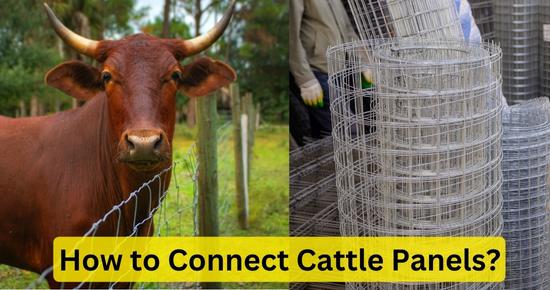It’s quite easy to connect cattle panels together. It would help to have the right tool for making joints between cattle panels. Fortunately, there are a lot of tools available to connect cattle panels. The most commonly used & cost-effective tools are pieces of metal wire, zip ties & hog rings.
Below, we’ve discussed a set of tools used to attach cattle panels.
How to connect cattle panels together?
To attach cattle panels or hog panels, you can use metal wire, metal or plastic zip ties, hog rings, wire panel hinges, hose clamps & split bolts. Besides this, you can use any hard metal wire available at home.
For a cost-effective option, go for zip ties, hog rings, or metal wire. However, for temporary cattle panel fencing, use wire panel hinges.
After installation, make sure the joint is secure. If using metal wire or zip ties, trim the extra wire & bend the sharp edges. Welding is also an option for permanent cattle panel fencing.
Method 1: Cut the panel’s ends & twist with each other
Cut off the last vertical wire of the cattle panel. Intervene the horizontal wires through the end of the other cattle panel. Bend the wires & twist them completely over the first cattle panel.
This way, you will not need any tool for attaching cattle panels together.
Method 2: Connect cattle panels with metal Wire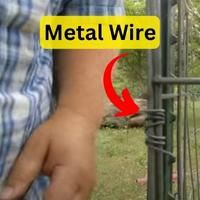
A metal wire is the most useful & cost-effective tool for attaching cattle panels. Metal wire pieces are often readily available in most household storerooms. Use thick hard wires between 10-14 gauge.
Price: A coil of 50 feet of metal wire costs around 10$, which would be more than enough for the project.
Steps:
- Cut a piece of wire around 10 inches.
- Align the ends of the cattle panel together.
- Wrap the wire around the ending vertical wires of cattle panels.
- Twist the ends of wires around each other using a plier until the cattle panels are securely connected.
- Similarly, attach cattle panels at multiple points after regular intervals.
- Trim the sharp edges & excess panel connecting wire for a smooth finishing & neat look.
- Bend the ends in a position so animals can’t approach them & get injured while rubbing or running.
Method 3: Attach cattle panels with zip ties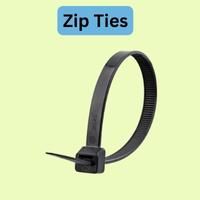
You can also use heavy-duty metal or plastic zip ties. Metal zip ties are ideal for connecting heavy-duty cattle panels. If using metal zip ties, ensure they are rust-resistant (galvanized) to prevent corrosion.
Plastic(nylon) zip ties are also available in different lengths & widths. If you want to use plastic zip ties, use thicker ones that are ultraviolet(UV) resistant to last long in intense sunlight.
Besides connecting cattle panels, you can use zip ties to attach cattle panels to T-posts or metal posts.
Price: A pack of 100 heavy-duty stainless steel or plastic zip ties usually costs 10-15$.
- Use zip ties at regular intervals of around 10 feet.
- Don’t over-tighten zip ties, as they may break due to the tension & weight of cattle panels.
- Trim the excess zip ties, especially the metal ones, after tightening them.
Method 4: Using Hog Rings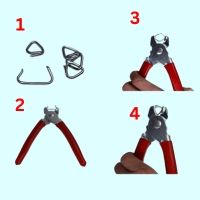
Hog rings are small, C-shaped metal fasteners used for various applications, primarily in attaching wire fences. Opt for heavy-duty hog rings, as cattle panels are quite heavy.
Price: Hog rings are most cost-effective as a pack of 1000 costs around 12$.
Steps to Install:
- To attach cattle panels using hog rings, align both ends of castle panels adjacent to each other.
- Then, wrap the hog ring around both ending vertical wires of both cattle panels.
- At last, use a plier/plass or hog ring plier to bend the hog ring close.
As hog rings are used for lightweight wire fence attachment, so use hog rings frequently at every few inches.
Method 5: Wire Panel Connector Hinge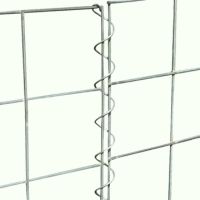
Cattle panel hinges are made of stainless steel and designed as a long spiral wire. They offer several advantages to attaching cattle panels, especially where quick and temporary fencing solutions are needed.
This innovative hardware eliminates the need for attachment clips or wires, making the process easier. These hinges are removable & reusable. Hence, they can serve you the longest time as compared to other tools.
Price: A pack of 5, 4-foot-long wire panel hinges costs around 40$.
Steps to install:
- To attach cattle panels using a panel connector hinge, align the ends of panels side by side, ensuring they are straight & touching each other.
- With the bottom end of the wire hinge, start threading it through the holes at the end of both panels.
- The spiral cattle panel hinge gets intervened around both ending vertical wires of the cattle panels from top to bottom, holding both panels securely.
Method 6: Hose clamp
Hose clamps are mechanical devices that secure hoses onto fittings, preventing leaks and ensuring a tight connection. They can also be used in DIY fencing projects to attach cattle panels.
Remember, they are more costly (around 5$ for 10 pieces) than other tools. So you should only use them if they are available at your home.
Method 7: Split Bolts:
Although split bolts are quite costly(around 2$ per piece). However, you can use them to attach cattle panels securely if they are available, you can use them to attach the cattle panels.
Frequently Asked Questions
How do you cut cattle panels?
A boltcutter is a heavy-duty wire-cutting tool similar to pliers commonly used to cut thick metal wires, hog fences & cattle panels. Both 14-inch or 24-inch bolt cutters work perfectly.
How do you attach the cattle panel to the t-post?
T-post clips, metal wires, zip ties, and T-post connectors can attach cattle panels to T-posts.
How do you attach cattle panels to wood posts?
Cattle panel to wood post connectors & fence staples can be used to attach cattle panels to wood posts. Barbed staples are ideal for a strong grip with wood.
How far apart should posts be for the cattle panel fence?
Cattle panel posts should be 8-10 feet apart. If using T-posts, keep the distance less, while you can increase the distance with wood posts.
What gauge wire should be used for cattle panels?
You can attach the cattle panel to 10-14 gauge hard metal wire.
Conclusion
As per my experience, metal wires are most commonly used as a cost-effective DIY method. If you are trying the same, trim the excessive wire.
Heavy-duty zip ties & hog rings are also cost-friendly DIY tools that serve you for years. However, you’ll need a plier/plass for using hog rings.
For a reusable option, cattle panel connector hinges are ideal options. You can use any tool that can strongly attach both panels.
If you still need any guidance, ask us in the comments below.

